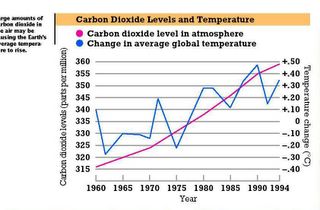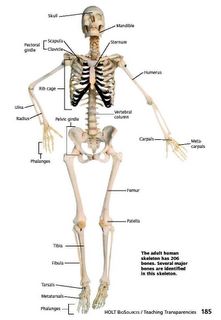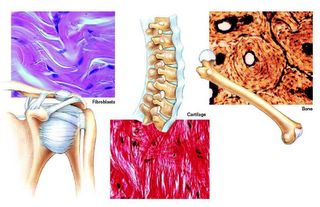ESJH Biology - Med 101
Mr. Gibney's Biology - Med 101 Class Fall 2006 -Check here for assignments, rubrics, extra credit, and life lessons
Friday, May 27, 2005
Sunday, May 22, 2005
Dear Students:
Best of luck during Finals this year. The best bet is to really review those old Residencies and to complete the Study Guide!!! Remember to bring your completed Exam Study Guide Packet for 15 pts on your exam day.
http://www.studygs.net/ Check this out for Study Hints.
Best,
J. Gibney
Sample Final Residency Questions
Sample Final Residency Questions
____ 1. Which of the following are examples of fossils?
a. shells or old bones b. any traces of dead organisms c. footprints of human ancestors, insects trapped in tree sap, and animals buried in tar d. All of the above
____ 2. The use of genetic engineering to transfer human genes into bacteria
a. is impossible with current technology. b. causes the human genes to manufacture bacterial proteins. c. results in the formation of a new species of organism. d. allows the bacteria to produce human proteins.
____ 3. PCR and DNA replication
a. are used in genetic engineering to make copies of RNA. b. require the same ingredients to make copies of DNA. c. are used in genetic engineering to make proteins. d. None of the above
____ 4. Which of the following describes the actions of HIV?
a. HIV attacks and cripples the immune system. b. HIV invades macrophages and helper T cells. c. HIV kills large numbers of helper T cells. d. All of the above
____ 5. B cells
a. sometimes remain in the blood for years. b. secrete antibodies. c. are stimulated by helper T cells. d. All of the above
____ 6. Which of the following is a density-independent regulatory factor?
a. food b. space c. temperature d. number of nesting sites
____ 7. The skin repels pathogens by
a. functioning as a barrier. b. producing antibodies. c. keeping you cool d. Playing rock n roll
____ 8. Scientists don’t use the common names of organisms because
a. an organism may have more than one common name. b. common names are too ambiguous. c. an organism rarely has the same name in different languages. d. All of the above
____ 9. The correct order of the biological hierarchy from kingdom to species is
a. kingdom, class, family, order, phylum, genus, species. b. kingdom, phylum, order, family, class, genus, species. c. kingdom, phylum, class, order, family, genus, species. d. kingdom, class, order, phylum, family, genus, species.
____ 10. The autonomic nervous system controls
a. reflexes. b. voluntary movement. c. involuntary functions of the internal organs. d. locomotion.
____ 11. The catchall kingdom is kingdom
a. Protista. b. Plantae. c. Animalia. d. Gibney.
____ 12. The science of classifying living things is called
a. identification. b. classification. c. taxonomy. d. speciation.
____ 13. Scientific names are written in what language?
a. English b. Greek c. Arabic d. Latin
____ 14. The functions of the skin include
a. defense against microbes. b. regulation of body temperature. c. prevention of dehydration. d. All of the above
____ 15. Viruses that use reverse transcriptase to cause their host cells to transcribe DNA from an RNA template are called
a. bacteriophages. b. antibodies. c. retroviruses. d. 4th period Bio class
____ 16. During swallowing, the air passage of the pharynx is covered by the
a. larynx. b. epiglottis. c. trachea. d. bronchi.
____ 17. Embryonic cells are organized into the major organ systems
a. during the sixth month. b. by the end of the first trimester. c. during the second trimester. d. just before birth.
____ 18. Fungi obtain nutrients by
a. photosynthesis. b. the nitrogen fixation process in their hyphae. c. digesting organic matter externally before absorbing it. d. None of the above
____ 19. As we move through the biological hierarchy from the kingdom to species level, organisms
a. vary more and more. b. are less and less related to each other. c. become more similar in appearance. d. always are members of the same order.
____ 20. The type of selection that may eliminate intermediate phenotypes is
a. direction selection. b. disruptive selection. c. polygenic selection. d. stabilizing selection.
____ 21. Pregnancy is often divided into three 3-month periods known as
a. quarters. b. fetal development. c. trimesters. d. ovarian cycles.
____ 22. Human population growth is most rapid in
a. Europe. b. the United States. c. Japan. d. developing countries.
____ 23. Which of the following are human diseases caused by protists?
a. amoebic dysentery b. toxoplasmosis c. leishmaniasis d. All of the above
____ 24. After the initial immune response subsides, B cells that patrol body tissues for long periods of time
a. are called helper T cells. b. develop into phagocytes. c. are called memory cells. d. cannot react to the original antigen.
____ 25. Phagocytes, such as macrophages,
a. produce strong antibiotics. b. secrete interferon. c. shut down immune responses. d. ingest and destroy pathogens.
____ 26. A reflex
a. may involve two or three neurons. b. is not under conscious control. c. is not learned. d. All of the above
____ 27. In which of the following ways do algae differ from most other protists?
a. All algae are unicellular and photosynthetic. b. Algae are photosynthetic and either unicellular or multicellular. c. All algae are unicellular and heterotrophic. d. All algae are multicellular and heterotrophic.
____ 28. In a certain aquatic ecosystem, low concentrations of pesticides in the water led to high concentrations of pesticides in organisms at the top of a food chain. This can BEST be explained by the fact that organisms at the highest level of a food chain ____.
a. are at the lowest trophic levels b. consume (eat) a large number of organisms from lower levels c. like to rap d. produce more offspring
____ 29. Which of the following would not be included in a description of an organism’s niche?
a. its trophic level b. the humidity and temperature it prefers c. its number of chromosomes d. when it reproduces
____ 30. HIV can be transmitted
a. through sexual intercourse with an infected person. b. by breast-feeding. c. by sharing contaminated hypodermic needles and syringes. d. All of the above
____ 31. Homologous structures in organisms suggest that the organisms
a. share a common ancestor. b. must have lived at different times. c. have a skeletal structure. d. are now extinct.
____ 32. The surface of Earth is protected from damaging ultraviolet light by
a. oxygen. b. ozone. c. hydrogen. d. nitrogen.
____ 33. Restriction fragment length polymorphism (RFLP) analysis is the procedure used for
a. making recombinant DNA. b. DNA fingerprinting. c. creating plasmids in bacterial cells. d. cloning cells that might contain specific genes of interest.
____ 34. Spontaneous generation has been offered as an explanation for
a. the birth of live offspring from a mother b. the germination of a seed. c. the appearance of maggots on rotting meat. d. All of the above
____ 35. Organisms well suited to their environment
a. reproduce more successfully than those less suited to the same environment. b. are always larger than organisms less suited to that environment. c. always dance more d. need less food than organisms less suited to that environment.
____ 36. Which of the following scientists developed the system of classifying organisms by assigning them a genus and species name?
a. Leakey b. Aristotle c. Darwin d. Linnaeus
____ 37. The stomach is involved in defense against infection by
a. regurgitating any pathogen that might be swallowed. b. secreting mucus that is carried away by cilia. c. possessing acid that destroys potential pathogens that are swallowed. d. sending potential pathogens to the liver for destruction.
____ 38. The physical location of an ecosystem in which a given species lives is called a
a. habitat. b. tropical level. c. community. d. food zone.
____ 39. Antibiotics
a. include penicillin, tetracycline, and streptomycin. b. may prevent bacteria from making new cell walls. c. are very effective treatments for bacterial diseases. d. All of the above
____ 40. Some species of mistletoe harm the trees on which they grow. The mistletoe’s roots grow into the tree and take nutrients from the tree. This relationship is an example of ____.
a. parasitism b. mutualism c. commensalism d. tupac and biggie
____ 41. Which of the following is a vestigial structure?
a. the human tailbone b. the bill of a finch c. flower color d. your nose
____ 42. Bacteria are the only organisms characterized as
a. unicellular. b. prokaryotic. c. eukaryotic. d. photosynthetic.
____ 43. Darvelle wants to study the effect of light on the growth of bean seedlings. How should she set up her experiment?
a. She should grow ten bean seedlings in a lighted area. b. She should grow ten bean seedlings in a dark area. c. She should grow five bean seedlings in a lighted area and eat the other seeds for lunch d. She should grow five bean seedlings in a lighted area and five bean seedlings in a dark area.
____ 44. The process by which a population becomes better suited to its environment is known as
a. accommodation. b. variation. c. adaptation. d. biogeography
____ 45. The scientific name of an organism
a. varies according to the native language of scientists. b. is the same for scientists all over the world. c. may refer to more than one species. d. may have more than one genus name.
____ 46. The age of Earth is estimated to be
a. 2 million years. b. 2 billion years. c. 2 trillion years. d. 4 billion years.
____ 47. The study of viruses is a part of biology because
a. they belong to the kingdom Eubacteria. b. they are about to become extinct. c. they are living organisms. d. they are active inside living cells.
____ 48. The process by which sperm leave the male’s body is called
a. secretion. b. ejaculation. c. diffusion. d. locomotion.
____ 49. Sperm and eggs are both
a. haploid. b. diploid. c. tetraploid. d. None of the above
____ 50. According to Darwin, evolution occurs
a. by chance. b. during half-life periods of 5,715 years. c. because of natural selection. d. rapidly.
____ 51. The debilitating effects of AIDS are due to inability of the immune system to
a. activate B cells and cytotoxic T cells. b. produce antibodies against pathogens. c. recognize and destroy infected cells. d. All of the above
Problem: 10 points each
52. Explain why the first trimester of pregnancy is such a critical time of development. Write your answer in the space below.
53. Choose ONE of the Following:
A) How alike and how different are bacteria and viruses? Compare the ways they replicate and cause disease.
B) Make a Venn Diagram comparing Viruses and Cells. List at least 5 items
54. Choose one of your favorite Reading Articles from this year. Explain what the main message of the article was? What new information did you learn from the article? Why is this important?
Bio Final Exam Fall 2004
Answer Section
MULTIPLE CHOICE
1. D
2. D
3. B
4. D
5. D
6. C
7. A
8. D
9. C
10. C
11. A
12. C
13. D
14. D
15. C
16. B
17. B
18. C
19. C
20. B
21. C
22. D
23. D
24. C
25. D
26. D
27. B
28. B
29. C
30. D
31. A
32. B
33. B
34. C
35. A
36. D
37. C
38. A
39. D
40. A
41. A
42. B
43. D
44. C
45. B
46. D
47. D
48. B
49. A
50. C
51. D
PROBLEM
52. Most of the major developmental events (for example, organ formation) occur during early pregnancy. Most miscarriages occur during this period. Fetal alcohol syndrome is due to alcohol use by pregnant women, especially during early pregnancy. Exposure to mutagens or drugs at this stage can cause serious damage to the embryo.
53. Bacteria are much larger than viruses
Bacteria replicate by binary fission while viruses must reproduce within the host cell
54. vary
Sunday, May 15, 2005
Webquest 5-16
We just watched a short video about coastal systems. Now you are going to embark on an exciting journey through our country’s Barrier Islands.
This is not like our normal webquest. Today your job is to develop an educated opinion as to whether or not people should build permanent structures on barrier islands. You will need to learn about the geological and physical nature of barrier islands, and how barrier islands change over time. You will look at development of barrier islands and find out how the beaches on these islands are maintained. You will find out how different states handle the protection or development of their barrier islands. You will also find out what happens to permanent structures that are built on barrier islands. Finally, you will form an opinion as to whether permanent structures should be built on barrier islands.
Once you have done your research, you will prepare an open letter to the editor of a newspaper in which you outline what you have learned about barrier islands and state your opinion on whether permanent structures should be built there. Your letter should include information about the geology and ecology of barrier islands as well as the changes they are subject to. Your goal is to convince readers of the newspaper that your conclusion is correct, and to encourage them to write to the appropriate agencies in support of your position.
DIRECTIONS:
-View Websites and Feel Free to Take notes in Microsoft Word
-Type your essay in the survey link below
-4th Period Survey
WEBSITES FOR YOU TO USE
What are barrier islands and how do they form?
· Florida Oceanographic Society: Barrier Islands. This site has background information on the formation of barrier islands.
· The Atlantic Coastline: The Nature of Barrier Islands. Visit this web site to learn how the barrier islands of North Carolina’s Outer Banks formed.
· Barrier Islands Formation. Here you can read about several different theories on the formation of barrier islands.
· Barrier Island and Barrier Beaches. At this site you can find out more about how the barrier islands of Georgia formed.
How do barrier islands change over time?
· Barrier Islands: Always Changing. Go to this site to find out how barrier islands change over time.
· Eastern Barrier Islands: Terra Un-Firma. At this National Science Foundation site you can discover how storms affect barrier islands.
· Mississippi Gulf Coast Barrier Islands. Here you can learn about the ecology of the barrier islands of Mississippi.
· Dynamics of Beaches and Barrier Islands. Visit this site to learn about barrier islands that have disappeared off the coast of New York State.
· Louisiana’s Barrier Islands: A Vanishing Resource. At this site you can learn about the changes in the barrier islands of Louisiana’s Gulf Coast.
How do various states handle development of barrier islands?
Altamaha River Barrier Islands. At this site you can find out how the state of Georgia handles development of Sapelo Island. Explore the site further to find out about beach, dune, estuarine, and marsh ecosystems.
Ecosystem Fact Sheets: Barrier Islands. Go to this site to find out more about the development of the barrier islands of Florida.
Barrier Islands. Go to this site to find out about the formation of the Gulf Islands National Seashore.
Sanibel Captiva Conservation Foundation: Barrier Islands. At this site you can find out how Florida protects two of its barrier islands.
Greenhouse Effect, Sea Level Rise, and Barrier Islands: Case Study of Long Beach Island, New Jersey. At this site you can find out how communities on barrier islands respond to a rise in sea level. .
What kinds of development occur on barrier islands?
Barrier islands, erosion, and mitigation efforts. Visit this site to find out what is happening to the barrier islands of New York.
Understanding Recreational Use on Barrier Islands. Go to this site to learn about the relationship between recreational use and physical features of Masonboro Island, a barrier island that is part of the North Carolina National Estuarine Research Reserve.
Managing Coastal Resources Case Studies. Visit this site to find out how North Carolina and Louisiana are protecting their barrier islands.
The Virginia/Maryland Barrier Islands. Go to this site for background information on the development and conservation of barrier islands in Virginia and Maryland.
The Need for Sand in Ocean City, Maryland. At this Coastal Estuarine Geology Program, Department of Natural Resources, State of Maryland site you can find out about the maintenance of beaches on barrier islands.
What happens to permanent structures built on barrier islands?
Renourish beaches or lose them. At this site you can find out how seawalls affect the beaches of barrier islands.
Coastal Erosion: Severity of the Problem. Visit this site to find out what happens when permanent structures are built on barrier islands.
Coastal Conflicts. At this USGS site you can learn about the impacts of hurricanes to the resort of Ocean City, Maryland.
Saving the Cape Hatteras Lighthouse from the Sea. Go to this site to find out what happened to this lighthouse and why.























